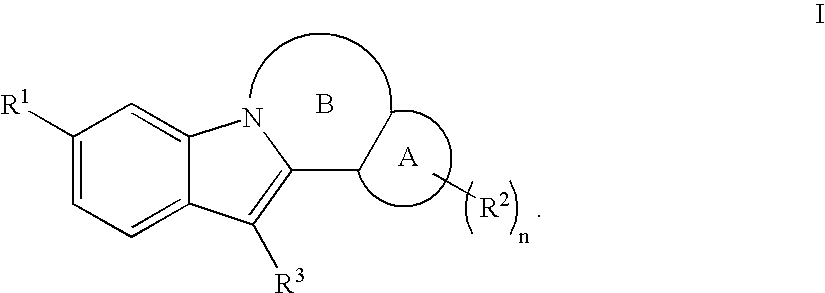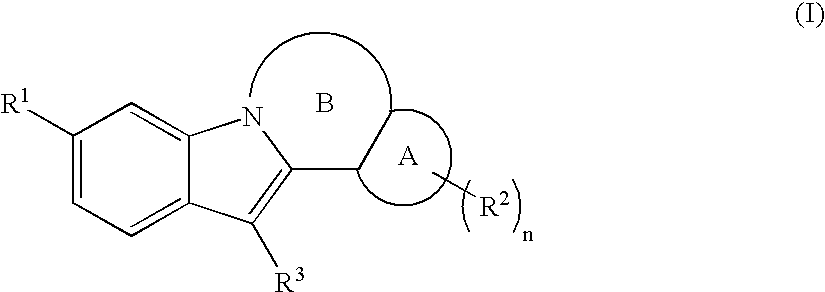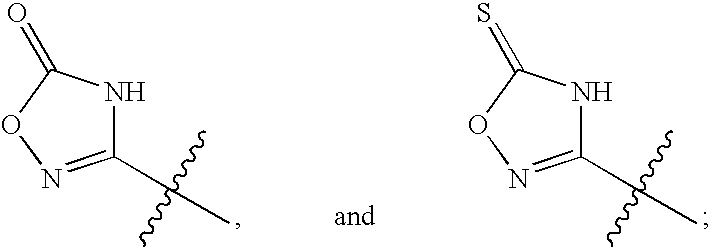Inhibitors of HCV replication
a technology of hcv replication and inhibitors, which is applied in the direction of amine active ingredients, cyclic peptide ingredients, medical preparations, etc., can solve the problems that none of these compounds have, to date, progressed beyond clinical trials and a substantial fraction of patients do not have sustained reductions in viral load
- Summary
- Abstract
- Description
- Claims
- Application Information
AI Technical Summary
Benefits of technology
Problems solved by technology
Method used
Image
Examples
example 9
[0290]
[0291](±)-13-Cyclohexyl-6,7-dihydro-6-(morpholinylcarbonyl)-5H-indolo[2,1-a][2]benzazepine-10-carboxylic acid. TBTU (69 mg, 0.22 mmol) was added to a stirred solution of racemic 14b (60 mg, 0.0.144 mmol), morpholine (19 μL, 0.22 mmol), and N,N-diisopropylethylamine (300 μL, 1.7 mmol) in DMF (3 mL). The mixture was shaken at 22° C. for 18 hr. The resulting solution was injected on a Shimadzu preparative liquid chromatograph. The product containing fraction was concentrated on a Speed Vac® to leave methyl 13-cyclohexyl-6,7-dihydro-6-(morpholinylcarbonyl)-5H-indolo [2,1-a][2]benzazepine-10-carboxylate as a colorless solid (60 mg, 86%). ESI-MS m / z 487 (MH+).
[0292]Sodium hydroxide (200 μL, 0.2 mmol) was added to a solution of the preceding methyl ester (60 mg, 0.127 mmol) in methanol (1.2 mL) and tetrahydrofuran (1.2 mL) in a microwave vial. The vial was sealed and the contents heated at 90° C. for 10 min in a microwave apparatus, at which time the vial was cooled and additional Na...
example 10
[0294]
[0295]Methyl 13-cyclohexyl-6-(morpholinylcarbonyl)-5H-indolo[2,1-a][2]benzazepine-10-carboxylate. TBTU (145 mg, 0.45 mmol) was added to a stirred solution of 14a (R=H, 125 mg, 0.30 mmol), morpholine (26 μL, 0.30 mmol), and N,N-diisopropylethylamine 200 μL, 1.15 mmol) in DMF (2 mL). The mixture was stirred at 22° C. for 20 min. The resulting solution was injected on a Shimadzu preparative liquid chromatograph. The product containing fraction was concentrated on a Speed Vac® to leave methyl 13-Cyclohexyl-6-(morpholinylcarbonyl)-5H-indolo[2,1-a][2]benzazepine-10-carboxylic acid as a yellow solid (64 mg, 44%). ESI-MS m / z 487 (MH+), 1H NMR (500 MHz, CDCl3) δ 1.21 (m, 1H), 1.34-1.55 (m, 3H), 1.77 (m, 2 H), 1.91 (m, 1 H), 2.06 (m, 3 H), 2.83 (m, 1 H), 2.97-3.85 (m, 8 H), 3.97 (s, 3 H), 4.45 (m, 1 H), 5.07 (m, 1 H), 6.89 (s, 1 H), 7.41 (d, 1 H), 7.49 (m, 2 H), 7.57 (m, 1 H), 7.75 (m, 1 H), 7.89 (d, J=8.55 Hz, 1 H), 8.15 (s, 1 H).
example 11
[0296]
[0297]13-Cyclohexyl-6-(morpholinylcarbonyl)-5H-indolo[2,1-a][2]benzazepine-10-carboxylic acid. Sodium hydroxide (84 μL, 0.084 mmol) was added to a solution of the preceding methyl ester (25 mg, 0.052 mmol) in methanol (0.5 mL) and tetrahydrofuran (0.5 mL) in a microwave vial. The vial was sealed and the contents heated at 90° C. for 15 min in a microwave apparatus. The solution was acidified with dilute hydrochloric acid to precipitate the crude acid. The solid was collected and purified on the Shimadzu preparative liquid chromatograph. The product containing fraction was concentrated on a Speed Vac® to leave the titled compound as a colorless solid (17.3 mg, 71%). ESI-MS m / z 471 (MH+), 1H NMR (500 MHz, DMSO-D6) δ 1.14 (m, 1 H), 1.43 (m, 3 H), 1.70 (m, 2 H), 1.89 (m, 1 H), 2.05 (m, 3 H), 2.79 (t, J=15.87 Hz, 1 H), 3.49 (m, 8 H), 4.27 (m, 1 H), 5.17 (m, 1 H), 7.01 (s, 1H), 7.52-7.65 (m, 5 H), 7.90 (d, J=8.55 Hz, 1 H), 8.21 (s, 1H), 12.62 (s, 1 H).
PUM
 Login to View More
Login to View More Abstract
Description
Claims
Application Information
 Login to View More
Login to View More - R&D
- Intellectual Property
- Life Sciences
- Materials
- Tech Scout
- Unparalleled Data Quality
- Higher Quality Content
- 60% Fewer Hallucinations
Browse by: Latest US Patents, China's latest patents, Technical Efficacy Thesaurus, Application Domain, Technology Topic, Popular Technical Reports.
© 2025 PatSnap. All rights reserved.Legal|Privacy policy|Modern Slavery Act Transparency Statement|Sitemap|About US| Contact US: help@patsnap.com



